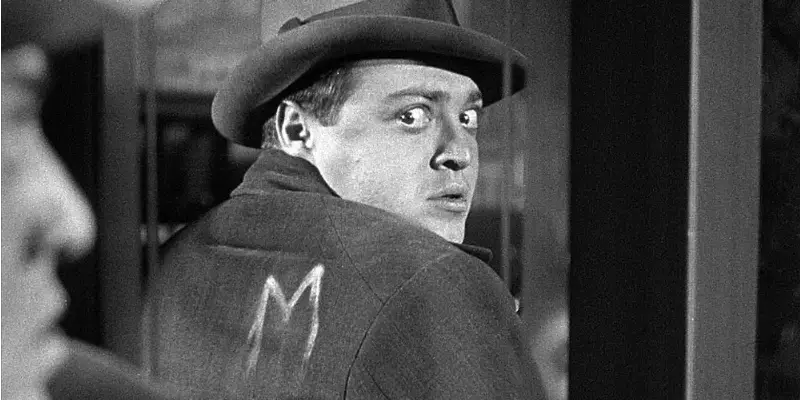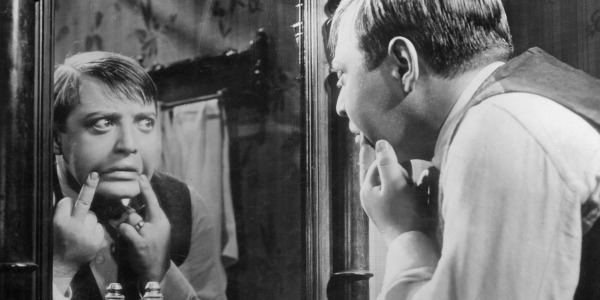Fritz Lang’s M And The Use Of Sound

Has a soft spot for Hammer Horror films and is…
German silent cinema of the 1920’s produced some of the most influential directors in the art of film making. Most directors and screenwriters working during this period were highly influenced by the German Expressionism art movement. Directors displayed Expressionism art in their films by presenting a distorted reality, which showed the inner turmoil of the characters. Elaborate set designs, shadows and odd camera angles were just some of the techniques used to create this dark inner turmoil. F.W. Murnau, Robert Wiene and Fritz Lang were just some of the directors operating at this time whose work is a great example of Expressionism in cinema.
The Influence of German Silent Film
Murnau, Wiene and Lang’s influence can still be felt reverberating throughout cinema today. Murnau’s Nosferatu would go on to become one of the most significant early films of the horror genre. The Cabinet of Dr Caligari directed by Wiene would have a profound impact not only on the horror genre but also on film noir. Lang’s films encompassed a range of genres from action/adventure to crime and science fiction. His ground breaking silent science fiction feature Metropolis has had an enormous impact on the genre. Its influence can be seen in Ridley Scott’s Blade Runner; the layout of the city is similar to the one featured in Lang’s film. Three years after the release of Metropolis Germany’s first feature-length talkie was released.
The Blue Angel, directed by Josef von Sternberg and starring Emil Jannings and Marlene Dietrich, became Germany’s first feature-length talkie. Dietrich plays Lola, a beautiful cabaret performer who brings about the downfall of respectable college lecturer Rath. To showcase the new narrative tool of sound von Sternberg incorporated the use of song to dazzle the audiences. Not only does Lola’s singing enthrall the character of Rath but it also captures the viewer. The film was a major success and is now considered a masterpiece of German cinema. As silent film faded away, the rumbling sound of dialogue could be heard throughout the cinema houses of Germany. Fritz Lang had yet to release a sound film, this was to change in 1931 with M.
In The Hall Of The Mountain King: Sound in M
M tells the story of child murderer, Hans Beckert’s (Peter Lorre), reign of terror in 1930’s Berlin. Hysteria and panic sets in with each passing day that Beckert remains at large. As pressure mounts on law enforcement, Inspector Karl Lohmann (Otto Wernicke) tells his men to intensify their search for the killer. Lohmann and his men begin to disrupt the business of local gangs with their daily raids on their establishments. So, the mob decides to try and find Beckert themselves in the hope that the police will ease their attention on them. This sets in motion a deadly chase between both the law and the underworld to catch the killer.

One of the striking aspects of Lang’s M is the absence of a film score. With most early sound films (and modern ones) directors would use a film score to conjure up emotions such as fear, tension and romance. Lang opens up the film with the title card and the sound of a gong, as if to call the audience to attention. The screen then turns black as we hear the sound of children playing an elimination game. When the first shot of the film appears, it reveals an apartment complex in which the children are playing the game. The words to the song are about a man in black coming for them, the game causes one of adults from the apartment block to shout at them to stop singing the song. Sound is used by Lang to create an atmosphere full of fear, paranoia and dread.
M contains one of cinema’s first uses of the leitmotif, which up until this point were used mainly in opera and utilised heavily by Richard Wagner. A leitmotif is a piece of recurring music which is associated with a character, place or situation. Some famous occurrences of the leitmotif include its use for characters such as Darth Vader in Star Wars and the ‘Man With No Name’ in Sergio Leone’s The Good, the Bad and the Ugly.
Lang’s employment of a leitmotif is one of the film’s crucial uses of sound. The leitmotif in M is diegetic and is whistled by the killer Hans Beckert (Lang himself dubbed the sound as actor Peter Lorre was unable to whistle). Beckert is heard whistling In The Hall Of The Mountain King throughout the film, generally off-screen, just before he picks his victims. The tune alerts the audience to the presence of Beckert (who is still off-screen) thus helping build the tension in the film.
The use of the leitmotif also gives us a glimpse into the psychological make-up of Beckert. As he approaches his victim, or is in a stressful situation, the whistling begins to become shaky and out of tune. Film critic Lotte Eisner states “The murderer’s whistling is both a motif and a psychological quirk”. Through the use of sound Lang brings another layer of complexity to the film’s main character. The leitmotif also brings about the downfall of Beckert, due to a blind beggar recognizing the tune he whistles, thus setting up the last act. The fact that it is a blind beggar who recognises Beckert through sound is also a clear sign of the ponderous effect sound has on the plot of M.

Lang uses sound to create a parallel between the mob and the police who are tracking down the killer Beckert. Even though the parties don’t share the same scenes Lang has their conversations overlap into one another. A prime example of this is when the head of the mob is addressing his men, Lang cuts to the chief of police who is also addressing his men. Lang then has the chief complete a sentence and action that the head of the mob started in the previous scene. This can be read as both sets of parties, even though on opposite sides of the law, being one and the same when it comes to this case.
Most of the action in M take place on the busy streets of Berlin, with the accompanying sounds of the active city. However the film also has many scenes in which there is an unnatural silence. During one of the police raids on the mob’s gambling den a striking aspect of the scene is found in the absence of sound on the streets. Although the raid takes place at night not a single sound is heard and one would think that they were watching a silent film as the action unfolds. Lang breaks the silence with the shriek of a whistle which indicates the start of the police raid. This is another example of sound (even when not present) taking centre stage, and Lang manipulating it to get the desired effect.
Conclusion
Putting sound to one side for the moment, Lang’s M is also remarkable for its subject; a paedophile child killer. Its daring plot was unthinkable in the 1930’s but Lang managed to get it past censors (barring one scene which is now lost). Although the Nazi Party later banned the film after they came into power. The reason it passed the censors is because of how Lang depicts the action. He never exploits the subject and handles the material tastefully. A murder is never shown on-screen, a ball rolling away is enough to conjure up horror and disgust. Praise must also be given to screenwriter Thea von Harbou, Lang’s then wife, who co-wrote the screenplay. With this approach, and his very skilful use of sound, Lang created one of German cinema’s masterpieces.

Fritz Lang’s foray into using sound in a film brought about a stunning accomplishment. Sound is never an afterthought to accompany a scene, it is focus of almost every scene in the film. He approached sound editing as if he were editing scenes, chopping certain sounds and highlighting others in order to create the right mood. Film historians David Bordwell and Kristin Thompson in their book Film History had this to say about Lang’s M: “He experimented with sound bridges, carrying over the sound, particularly voices, from one scene into the next – a technique that would not be commonly used until modern Hollywood cinema”. High praise from two of cinema’s most respected academics.
The maturity which Lang displays in M regarding his direction and use of sound is the reason the film remains so critically acclaimed today. Even though the film is over eighty years old it still remains fresh and hasn’t just become an artefact of cinema, unlike the first ever sound film The Jazz Singer. Which, while undeniablly important to the history of cinema, as entertainment it isn’t all that good and has not aged well.
Fritz Lang considered M to be the best film he’d directed, afterwards he moved to America and directed many westerns and noir films. Lang’s early career broke so much ground that by the end of it he seemed to be on autopilot. So, while some of these features make for very compelling viewing, 1945’s Scarlet Street is terrific, he never made a film like M again. A film which benefits from multiple viewings as something new always comes to the foreground and Lang’s genius becomes more clear.
Can you name another film that is not in the horror genre where sound is so important to the plot?
Does content like this matter to you?
Become a Member and support film journalism. Unlock access to all of Film Inquiry`s great articles. Join a community of like-minded readers who are passionate about cinema - get access to our private members Network, give back to independent filmmakers, and more.
Has a soft spot for Hammer Horror films and is constantly looking to further his knowledge of cinema.












